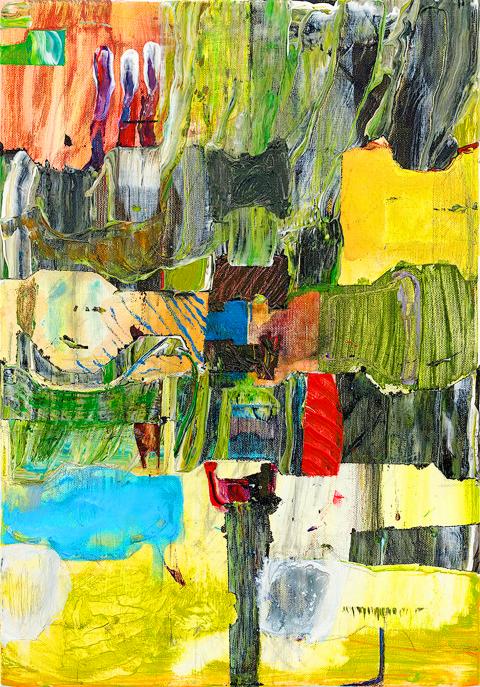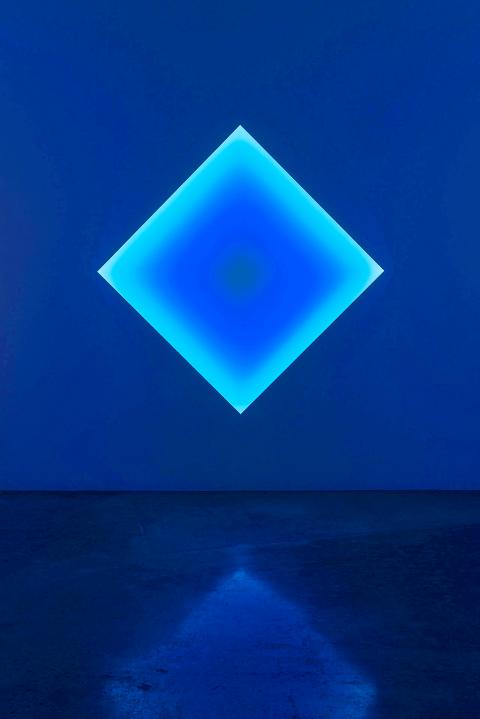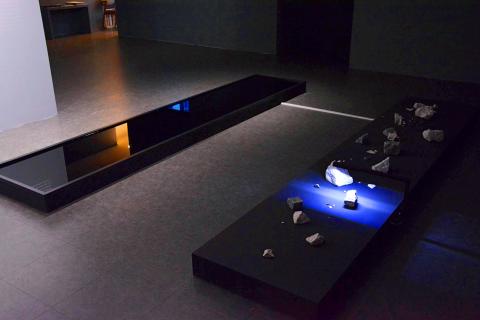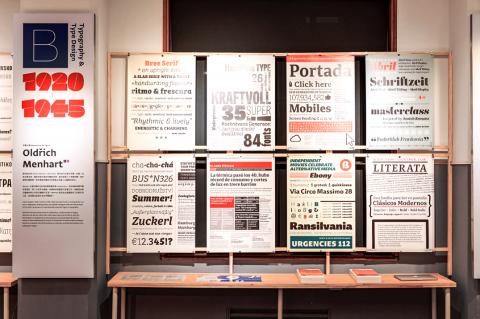Lin Yi-wei (林奕維) is a Taiwanese painter based in Frankfurt and Kaohsiung. His solo exhibition, Hourglass (沙漏), at Gai Art features a series of paintings that correspond to 11 journal entries written in the past year. In these entries, the artist reflects on the immigrant experience, workers and homosexuals. The journals not only serve as inspiration for his paintings, they embody a continuous flow of thought that is intertwined with his daily encounters. Each entry and its corresponding painting are given the same name, and each name announces a strong narrative, such as Reciprocal Shadow: Nudity Camp at Lakeside and Pleasant to Hear the Song Played by DJ Tonight. In contrast, the paintings themselves are suggestive, ambiguous and often contain abstract use of paint. The Road to Return Home for example, depicts stripes of textured color fields stacked on each other, creating a repetitive visual order.
■ Gai Art (㮣藝術), 9-4, Pucheng St, Taipei City (台北市浦城街9之4號), tel: (02) 2363-2000. Open Tuesdays to Sundays from 1:30pm to 7pm
■ Until Dec. 30

Photo courtesy of Gai Art
This year marks 100 years since the birth of Czechoslovakia, a former independent state in Central Europe that formed what we know today as the Czech Republic and Slovakia. On such an occasion, a group design show serves as an opportunity to look back on the shared cultural developments between the now-separated nations. 100 Years of Czech and Slovak Graphic Design (捷克與斯洛伐克平面設計100年) is presently on view at the Taiwan Design Museum. The show mostly consists of cultural publications collected by curator Joe Chang (張軒豪) during his research travels in Europe. Chang is also responsible for the main visual design of the exhibition, which utilizes the Slovakian typeface Klimax, and adopts the colors of both national flags. The exhibited material is organized by chronology and grouped by decade as assemblages of periodic impressions. With a special focus on graphic design, illustration and typology, the show also includes a separate presentation of the International Biennial of Graphic Design Brno, one of the world’s oldest design biennials, which debuted in 1963. There are special talks and events featuring the curator of the Biennial Brno Marta Sylvestrova, and Czech illustrator Tomas Rizek. For more information, visit: www.songyancourt.com/en/tdm/.
■ Taiwan Design Center (台灣設計館), 133, Guangfu S Rd, Taipei City (台北市光復南路133號), tel: (02) 2745-8199. Open Tuesdays to Sundays from 9:30am to 5:30pm
■ Until Feb. 24

Photo courtesy of Alien Art Centre
Chini Gallery (采泥藝術) presents Super Penetrating, a solo exhibition by Chang Yung-ta (張永達). Chang is a multidisciplinary artist whose works span audio-visual art, experimental sound, installation and live performance. His practice centers on observing subtle details in daily life, which he translates into artworks to arouse the senses “in [today’s] highly visual-oriented environment.” The show features installations embedded with micro-sensors that detect radiation signals present in the gallery space. These signals are amplified and made visible through audio and visual techniques. The artist reflects on the significance of this data and the technologies that allow us to perform such monitoring. The artist asks: “In the process of continuously detecting, monitoring, translation and reproduction of data, does that provide us with data of the ideal and safe range? Or is it simply the emergence of the anxiety and warning signs of crises in a technological world that has an uncertain future?”
■ Chini Gallery (采泥藝術), 48, Ln 128, Jingye 1st Rd, Taipei City (台北市敬業一路128巷48號), tel: (02) 7729-5809. Open Tuesdays to Sundays from 10:30am to 7pm
■ Until Jan. 1

Photo courtesy of Chini Gallery
TKG Plus will open two solo shows this weekend. In Niu Jun-qiang Solo Exhibition 2018 (牛俊強個展2018), Niu Jun-qiang (牛俊強) has created videos, experimental films, photographs and installations that explore the possibility of developing shared narratives based on multiple individual histories. In this show, the artist explores the condition of sight in contemporary times. He opens with several questions: Do we truly possess the ability to see? What happens after we entirely lose our ability to see? Quoting Aristotle, the artist points toward a more philosophical interpretation of sight as a departure point for contemplating the self, existence and the universe. Root of Desire (欲貪孰為本), a solo exhibition by Charwei Tsai (蔡佳葳), features a new body of drawings and video installations that draw inspiration from the Buddhist text, Vimalakirti Sutra. “This ancient spiritual text is one of the first recorded in Asia that discusses women’s rights and gender equality,” writes the gallery. In several works, excerpts of the text are incorporated to address correlations between desire, rootlessness, impermanence, nature and emptiness.
■ TKG Plus Projects, B1, 15, Ln 548, Ruiguang Rd, Taipei City (台北市瑞光路548巷15號B1), tel: (02) 2659-0798. Open Tuesdays to Sundays from 11am to 7pm
■ Until Jan. 20

Photo courtesy of Taiwan Design Museum
Alien Art Centre presents James Turrell, featuring prominent American artist and avid pilot of the same name. Turrell is known for his awe-inspiring light installations that push the limits of human perception. “My work has no object, no image and no focus,” writes the artist. “You are looking at what you are looking [at]. What is important to me is to create an experience of wordless thought.” Turrell is a pioneer of the Light and Space movement, a direction of American minimalist art in the 1960s and 70s that concerned itself with geometric shapes and illumination and its effect on the environment. One of Turrell’s most famous pieces is his ongoing project, Roden Crater, in northern Arizona. The artist has worked within the bowel of a crater to “cut a series of chambers, tunnels and apertures within the volcano that heighten our sense of the heavens and earth.” At Alien Art Centre, Turrell presents his recent work, Corinth Canal Diamonds (Squares on point) Glass, 2016, which is part of a glass-based series initiated in 2004. The work takes inspiration from a narrow navigational route in the Greek archipelago. Traveling along the canal, “while one can only glimpse the broad horizon line, the sky is framed by a high natural wall,” writes the art center in a press release.
■ Alien Art Centre (金馬賓館), 111, Gushan 1 Rd, Kaohsiung City (高雄市鼓山一路111號), tel: (07) 972-1685. Open Wednesdays to Sundays from 10am to 6pm
■ Until Dec. 30

April 14 to April 20 In March 1947, Sising Katadrepan urged the government to drop the “high mountain people” (高山族) designation for Indigenous Taiwanese and refer to them as “Taiwan people” (台灣族). He considered the term derogatory, arguing that it made them sound like animals. The Taiwan Provincial Government agreed to stop using the term, stating that Indigenous Taiwanese suffered all sorts of discrimination and oppression under the Japanese and were forced to live in the mountains as outsiders to society. Now, under the new regime, they would be seen as equals, thus they should be henceforth

Last week, the the National Immigration Agency (NIA) told the legislature that more than 10,000 naturalized Taiwanese citizens from the People’s Republic of China (PRC) risked having their citizenship revoked if they failed to provide proof that they had renounced their Chinese household registration within the next three months. Renunciation is required under the Act Governing Relations Between the People of the Taiwan Area and the Mainland Area (臺灣地區與大陸地區人民關係條例), as amended in 2004, though it was only a legal requirement after 2000. Prior to that, it had been only an administrative requirement since the Nationality Act (國籍法) was established in

With over 80 works on display, this is Louise Bourgeois’ first solo show in Taiwan. Visitors are invited to traverse her world of love and hate, vengeance and acceptance, trauma and reconciliation. Dominating the entrance, the nine-foot-tall Crouching Spider (2003) greets visitors. The creature looms behind the glass facade, symbolic protector and gatekeeper to the intimate journey ahead. Bourgeois, best known for her giant spider sculptures, is one of the most influential artist of the twentieth century. Blending vulnerability and defiance through themes of sexuality, trauma and identity, her work reshaped the landscape of contemporary art with fearless honesty. “People are influenced by

The remains of this Japanese-era trail designed to protect the camphor industry make for a scenic day-hike, a fascinating overnight hike or a challenging multi-day adventure Maolin District (茂林) in Kaohsiung is well known for beautiful roadside scenery, waterfalls, the annual butterfly migration and indigenous culture. A lesser known but worthwhile destination here lies along the very top of the valley: the Liugui Security Path (六龜警備道). This relic of the Japanese era once isolated the Maolin valley from the outside world but now serves to draw tourists in. The path originally ran for about 50km, but not all of this trail is still easily walkable. The nicest section for a simple day hike is the heavily trafficked southern section above Maolin and Wanshan (萬山) villages. Remains of